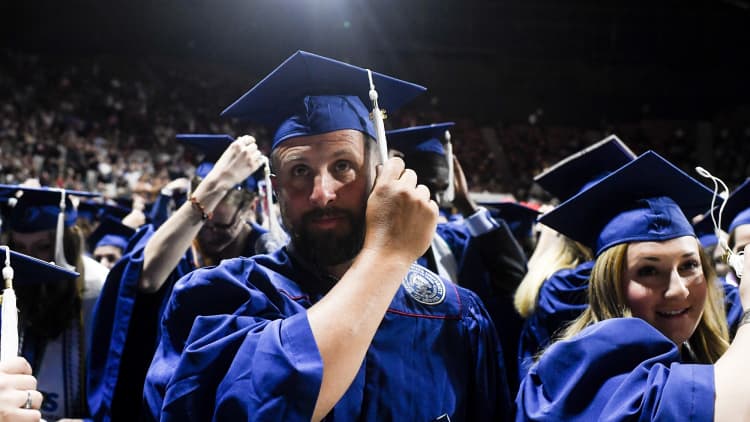On Jan. 2, the Department of Defense announced that the U.S. military had killed Qasem Soleimani, the head of the Iranian Revolutionary Guard's Quds Force, at the direction of President Donald Trump.
Within hours of the Pentagon's announcement, Mohammad Javad Zarif, Iran's Foreign Minister, called the strike an "act of international terrorism" and "a foolish escalation" on Twitter.
The news brought fears about a potential military conflict, and "WWIII" began trending on Twitter.
Soon, "FAFSA" was also trending, with users anxiously posting about how the Free Application for Federal Student Aid, abbreviated as FAFSA, requires most male students between the ages of 18 and 25 to register with Selected Service, known as the draft, in order to receive federal financial aid.
However, national security experts stress that even though students have signed this form, a draft is extremely unlikely.
Here's why the FAFSA is linked to the draft — and why experts say there is little need to worry about a draft just yet:
Military legacy of the FAFSA
Concerned students are right that the FAFSA registers most male students for the draft.
Financial aid is indeed linked to registry with the Selective Service System. In question 22 of the FAFSA, applicants are asked if they are registered with the System, if they are male and between the ages of 18 and 25. If they have not yet registered, they are asked to select "Register Me," which adds them to the System online.
According to the Department of Education's Student Financial Aid Handbook, "any male required to register with Selective Service at any time must have done so to receive federal student aid." That includes Pell Grants, Federal Work Study and Stafford Loans.
The rule applies to both U.S. citizens and non-citizen residents.
Students applying for federal aid who are not yet 18 do not need to register with Selective Service, but will need to once they turn 18.
Current law dictates that "only persons assigned the sex of male at birth are required to register," regardless of gender identity.
There are limited exceptions for select groups, such as those who are already in the armed services, those who are hospitalized and those who are incarcerated.
Federal aid for education has long had ties to military service in the U.S.
"The FAFSA wasn't really created for civilians," Charlie Javice, founder and CEO of Frank, an online FAFSA platform, tells CNBC Make It. "It was really created for our veterans and then it evolved and evolved and evolved."
U.S. federal student aid policy's military ties first trace back to the Servicemen's Readjustment Act, better known as the "GI Bill," which was signed into law in 1944 by President Franklin D. Roosevelt. The G.I. Bill has provided funds for hundreds of thousands of American veterans to go to college and trade school.
Later, during the Cold War, the Soviet Union's successful launch of the Sputnik satellite inspired Congress to expand the U.S.'s higher education funding, passing the National Defense Education Act of 1958. Signed by President Dwight D. Eisenhower, the law created low-interest federal student loans, debt cancellation for students who became teachers and graduate fellowships for students who studied specific fields like mathematics and engineering.
This legacy of coordinating education policy alongside national security interests continued through the 1990s, when the Higher Education Amendments of 1992 created the FAFSA, by merging existing methodology for assigning student aid for veterans into a free national application available to all students.
Today, nearly 20 million students fill out the FAFSA each year.
Why a draft is unlikely
However, fears that a completed FAFSA application will lead to being drafted and deployed by the U.S. armed forces in response to the recent events Iran are "overhyped," says Dan Byman, professor at Georgetown University and senior fellow in the Center for Middle East Policy at the Brookings Institution.
"One, there isn't a need for large numbers of U.S. forces, given the current security environment," he tells CNBC Make It. What's more: "The way military operations have changed quite dramatically in recent decades, it requires a much more trained and professional force," Byman says. "A draft where people cycle in and out very quickly, actually isn't that good for modern military operations."
In addition to those logistics, a draft would also be a difficult political decision, he says.
"It would have to be after some sort of massive crisis," says Byman, adding that while recent actions in Iran will likely escalate conflict in the Middle East, it is too early to determine if this will grow into a modern war, including an invasion by the United States.
Like this story? Subscribe to CNBC Make It on YouTube!
Don't miss:



